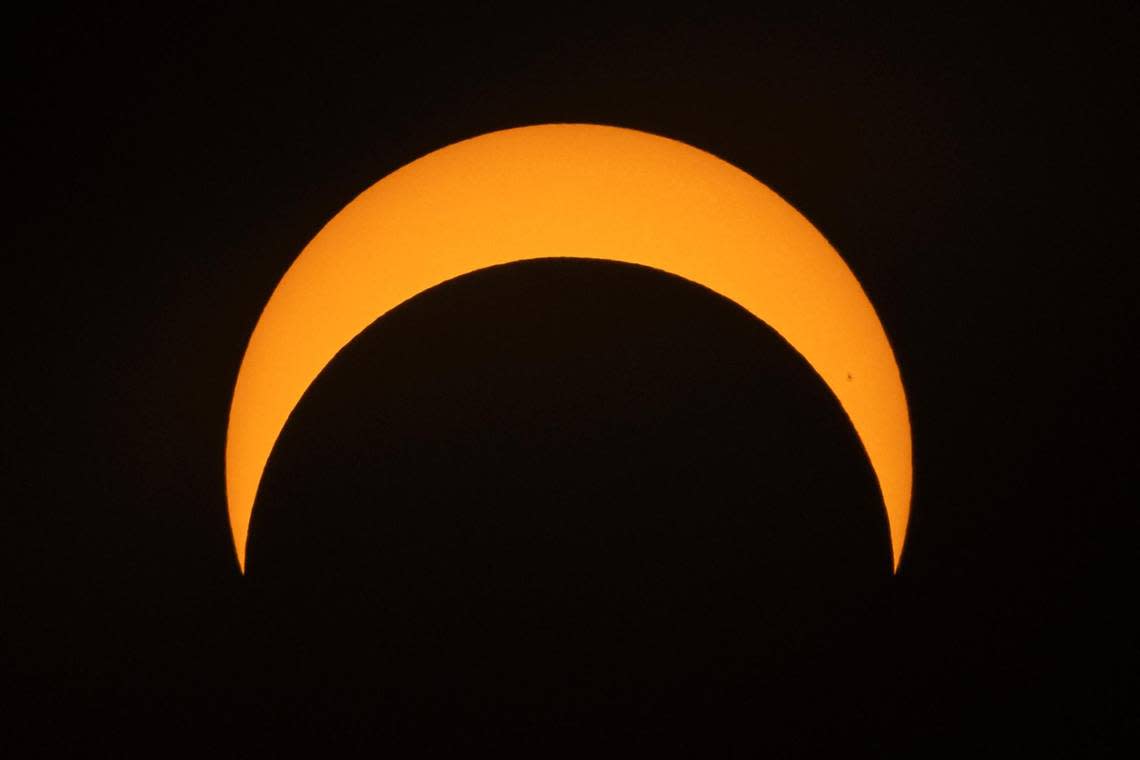Want to see the total solar eclipse? Here’s how far you’ll have to travel from Wichita

In less than a month, some parts of the U.S. will see the sun completely blocked out during a rare total solar eclipse.
The eclipse will pass over Mexico, Canada and the U.S. April 8. Mexico will be the first place to see the total eclipse, which will peak at 11:07 a.m.
The last time the U.S. saw an eclipse was last October, though it was a partial eclipse. That event, also called an annular eclipse, occurred when the moon passed between the sun and the Earth when it was farthest from the Earth. This causes a ring effect around the moon.
This next event is a rare total solar eclipse. During a total solar eclipse, the moon passes between the sun and the Earth completely blocking the face of the sun.
Wichita will only see this year’s eclipse in partiality, with an estimated coverage of 87.59% and peaking at 1:48 p.m.
But you can see better coverage of the sun from other Kansas locales, and we’ve rounded up this quick guide of the closest places you might see the total eclipse this April.
Where can I travel to in the U.S. to see eclipse totality?
With almost 100% coverage and about a 4.5-hour drive away, if you want to see an almost total solar eclipse, the closest location to Wichita is Fayetteville, Ark.
Peaking at 1:51 p.m. April 8 and lasting more than 2.5 hours, Fayetteville will see good coverage of the sun during the event.
If you’re looking for a quick road trip, hotel prices range from $54 to more than $300, according to travel site Hotels.com.
As for a complete blackout, Dallas is one of the closest cities you can travel to see totality, according to online global clock Time and Date.
Here’s a list of cities that will see totality this April, as well as the driving distance from Wichita and Hotels.com lodging prices if you’re interested in making the trip.
Dallas, Texas: 5.5 hours from Wichita (Hotel prices range from $89 to a luxury hotel for more than $1,000)
Idabel, Okla.: 5 hours and 49 minutes from Wichita (Only two hotels available in the $300 range)
Little Rock, Ark.: 6.5 hours from Wichita (Hotel prices range from $57 to more than $600)
Poplar Bluff, Mo.: 7 hours from Wichita (Hotel prices range from $90 to more than $800)
Paducah, Ky.: 9 hours from Wichita (Hotel prices range from $75 to more than $500)
Carbondale, Ill.: 8 hours and 12 minutes from Wichita (Hotel prices range from $100 to more than $400)
Evansville, Ind.: 9 hours from Wichita (Hotel prices range from $135 to more than $400)
Cleveland, Ohio: 14.5 hours from Wichita (Hotel prices range from $64 to more than $500)
Erie, Pa.: 16 hours from Wichita (Hotel prices range from $188 to more than $1,000)
Buffalo, N.Y.: 17.5 hours from Wichita (Hotel prices range from the $100 range to more than $600)
Burlington, Vt.: 24 hours from Wichita (Hotel prices range from $466 to more than $800)
Lancaster, N.H.: 25 hours from Wichita (Hotel prices range from $148 to more than $900)
Caribou, Maine: 29 hours from Wichita (Hotel prices all in the $300 range)
Where in Kansas will you see the most coverage?
If you want to stay in Kansas, but take a quick trip to see more coverage during this year’s solar eclipse, there are a few cities with a better view that Wichita.
Overland Park, a 2 hour and 45 minute drive from Wichita, will see the most coverage in the state, at 89.5%.
Other cities with more coverage than Wichita include, according to Time and Date, Lawrence (88.35% coverage), Olathe (89.49% coverage) and Osage City (88.10% coverage).
Lawrence and Olathe are about a 2.5-hour drive from Wichita, and Osage City is about 1 hour and 45 minutes away.
Home Depot and Lowe’s sell eclipse glasses in Wichita, and other stores may hop on the trend. The Kansas Lions Sight Foundation will also sell and, in some cases, donate eclipse glasses to the public.

